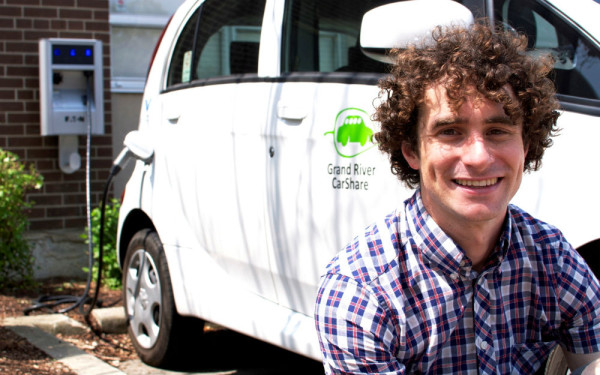Driving Electric at Work
Coordinated by Rebecca Spring, WWF-Canada’s Manager of Sustainable Transportation. Written by Julie Stauffer
James LaPointe loves the Mitsubishi i-MiEV parked outside his office at Region of Waterloo headquarters. “It’s quiet, it’s nimble and it’s actually got a little bit of kick,” says LaPointe, the Region’s transportation demand management principal planner.
The peppy plug-in vehicle is a recent addition to Community CarShare – an organization the Region has belonged to for the past three years. And while employees have access to a wide range of carshare vehicles, the i-MiEV has proved a popular choice for local site visits, events and meetings.
The electric vehicle is a first for Community CarShare, made feasible by a $15,000 grant from the Region’s Community Environmental Fund and $8,000 in provincial rebates. Although it cost more upfront than a conventional car, the forward-thinking co-op believes the long-term benefits are worth it.
For starters, the charging costs – roughly $40 a month – are a fraction of the fuel bills for the fleet’s gas-powered cars. Furthermore, no oil changes and fewer moving parts translate to less frequent trips to the mechanic. “There’s so little to do to take care of that car,” says Community CarShare Executive Director Janet MacLeod. “I don’t spend much time thinking about it”.”
Because driving the i-MiEV is so straightforward, members don’t need any special training. The one big thing to keep in mind? Battery range. Community CarShare adds a one-hour charging buffer after each reservation. While that may not enough time to completely top up the battery, MacLeod has found it usually gives the next person the kilometres they need.
“You just need to be conscious of the kind of trip you’re doing,” she says. That’s especially true in winter, when teeth-chattering temperatures reduce the i-MiEV’s average 100-kilometre range. On the rare occasion when poor planning meant the car ran out of juice, the co-op has quickly dispatched taxis to get drivers where they’re going. “It’s a process of learning and education and getting people familiar with it,” MacLeod explains.
Despite those hiccups, the i-MiEV has gotten rave reviews at the Region. Employees appreciate having an eco-friendly way to get around town, as well as the convenience of simply plugging in the car at the end of their trip. “I don’t ever have to worry about popping into a gas station,” says LaPointe. “You just set it and forget it.”


